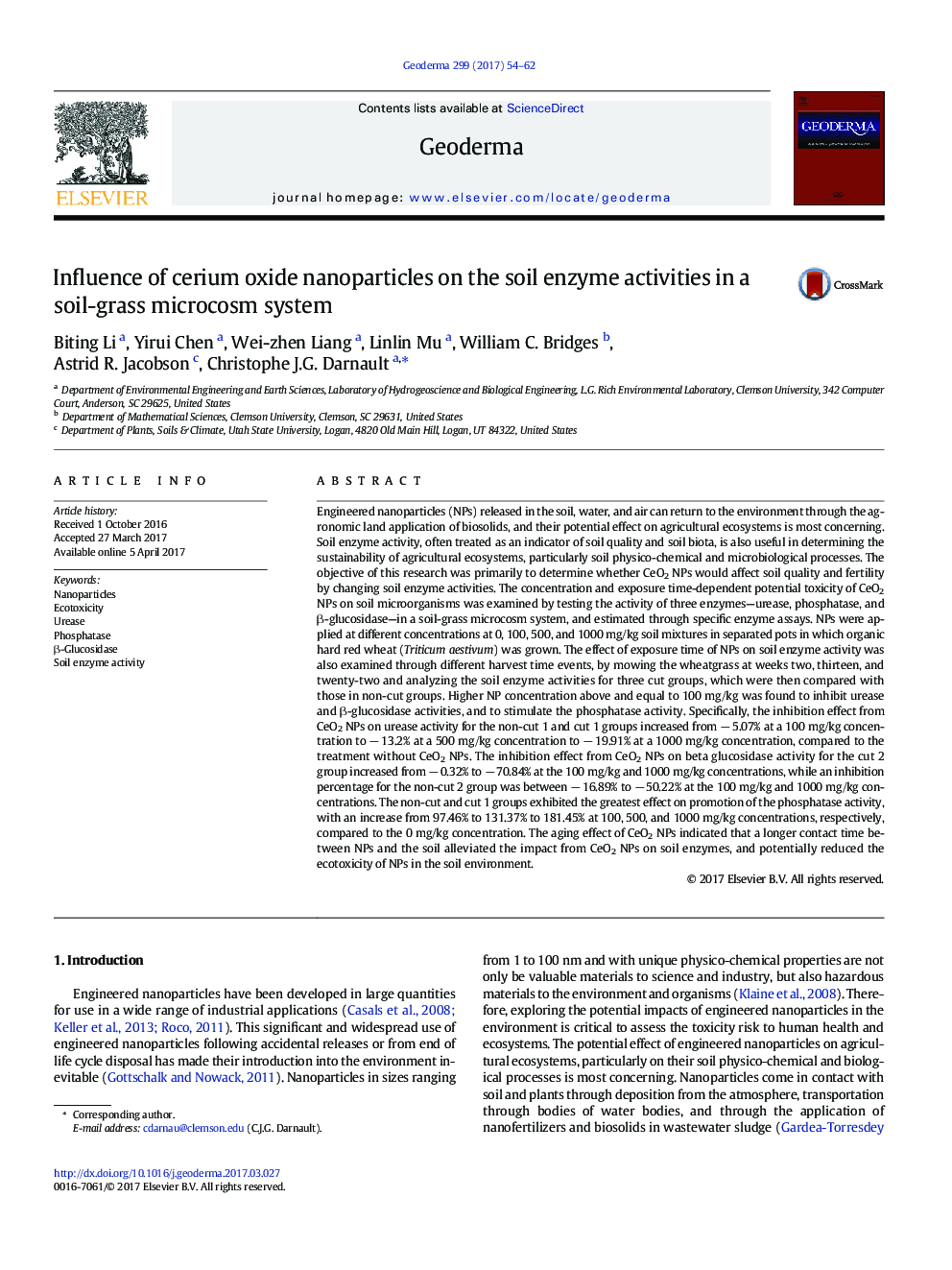| کد مقاله | کد نشریه | سال انتشار | مقاله انگلیسی | نسخه تمام متن |
|---|---|---|---|---|
| 5770533 | 1629418 | 2017 | 9 صفحه PDF | دانلود رایگان |
- CeO2 NPs exhibit both inhibitory and promotional effects on soil enzymatic activities.
- Influence of CeO2 NPs on soil enzymes is concentration and time dependent.
- Aging and exposure time reduce the impacts of CeO2 NPs on soil enzymatic activities.
Engineered nanoparticles (NPs) released in the soil, water, and air can return to the environment through the agronomic land application of biosolids, and their potential effect on agricultural ecosystems is most concerning. Soil enzyme activity, often treated as an indicator of soil quality and soil biota, is also useful in determining the sustainability of agricultural ecosystems, particularly soil physico-chemical and microbiological processes. The objective of this research was primarily to determine whether CeO2 NPs would affect soil quality and fertility by changing soil enzyme activities. The concentration and exposure time-dependent potential toxicity of CeO2 NPs on soil microorganisms was examined by testing the activity of three enzymes-urease, phosphatase, and β-glucosidase-in a soil-grass microcosm system, and estimated through specific enzyme assays. NPs were applied at different concentrations at 0, 100, 500, and 1000 mg/kg soil mixtures in separated pots in which organic hard red wheat (Triticum aestivum) was grown. The effect of exposure time of NPs on soil enzyme activity was also examined through different harvest time events, by mowing the wheatgrass at weeks two, thirteen, and twenty-two and analyzing the soil enzyme activities for three cut groups, which were then compared with those in non-cut groups. Higher NP concentration above and equal to 100 mg/kg was found to inhibit urease and β-glucosidase activities, and to stimulate the phosphatase activity. Specifically, the inhibition effect from CeO2 NPs on urease activity for the non-cut 1 and cut 1 groups increased from â 5.07% at a 100 mg/kg concentration to â 13.2% at a 500 mg/kg concentration to â 19.91% at a 1000 mg/kg concentration, compared to the treatment without CeO2 NPs. The inhibition effect from CeO2 NPs on beta glucosidase activity for the cut 2 group increased from â 0.32% to â 70.84% at the 100 mg/kg and 1000 mg/kg concentrations, while an inhibition percentage for the non-cut 2 group was between â 16.89% to â 50.22% at the 100 mg/kg and 1000 mg/kg concentrations. The non-cut and cut 1 groups exhibited the greatest effect on promotion of the phosphatase activity, with an increase from 97.46% to 131.37% to 181.45% at 100, 500, and 1000 mg/kg concentrations, respectively, compared to the 0 mg/kg concentration. The aging effect of CeO2 NPs indicated that a longer contact time between NPs and the soil alleviated the impact from CeO2 NPs on soil enzymes, and potentially reduced the ecotoxicity of NPs in the soil environment.
Journal: Geoderma - Volume 299, 1 August 2017, Pages 54-62
